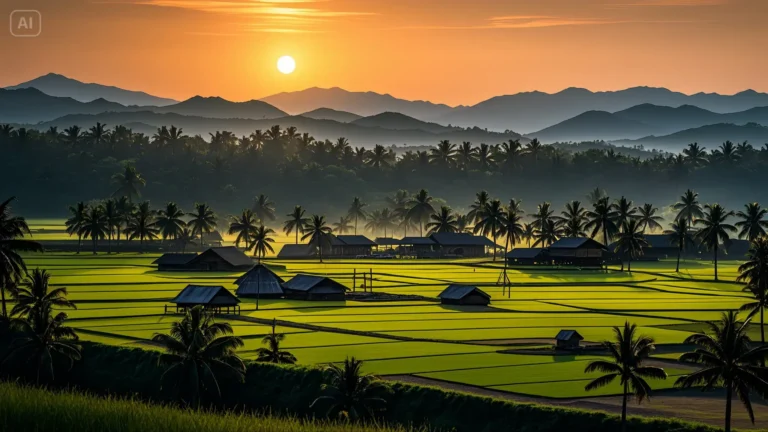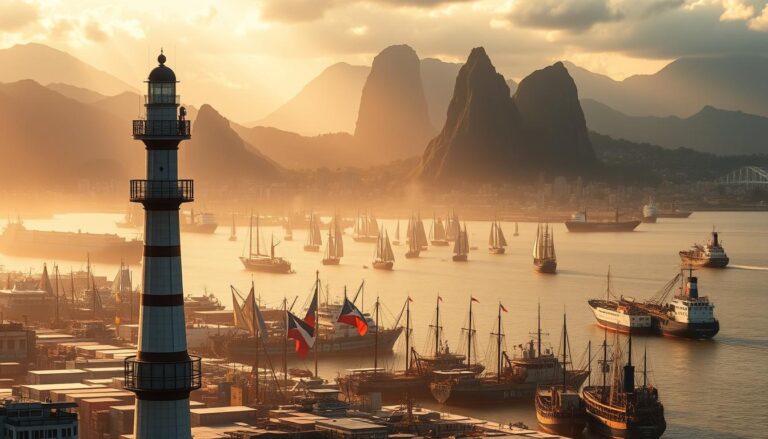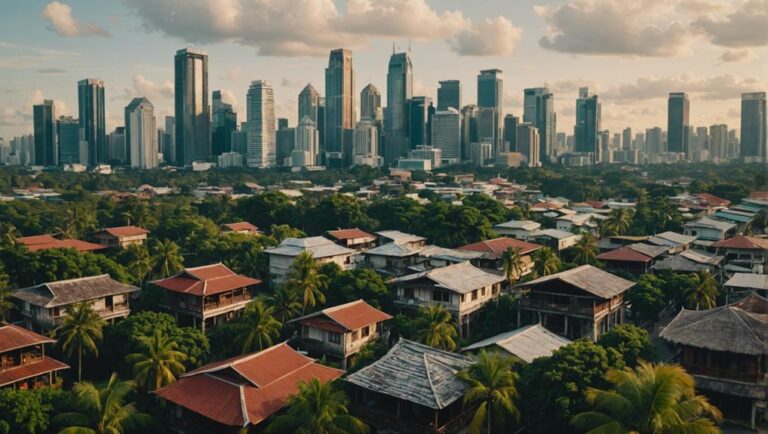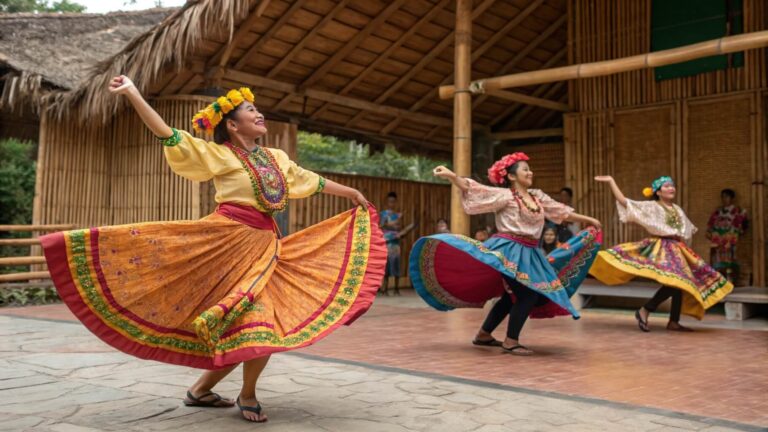Economic History of the Philippines: From Agriculture to Industry
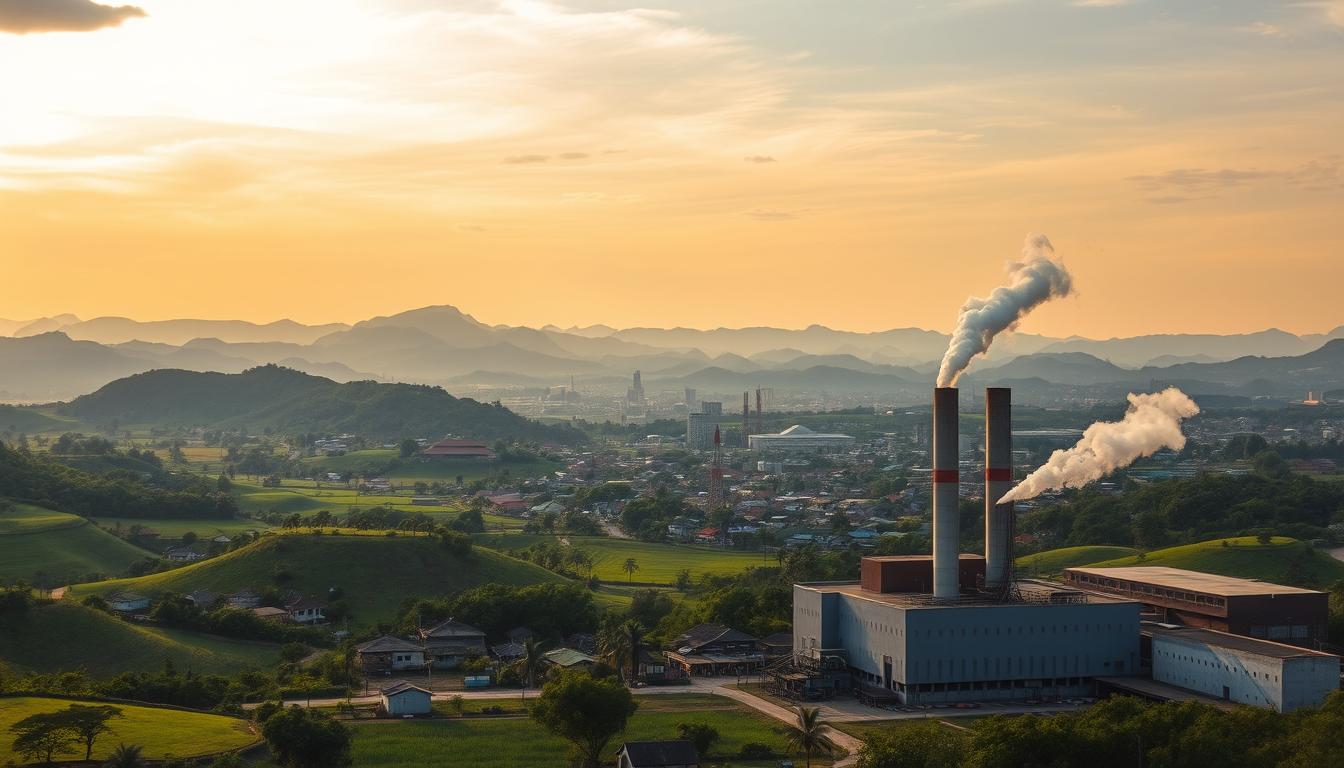
The Philippines’ economic journey is quite impressive. It started with farming and fishing and now has a wide range of industries. This change took centuries, influenced by colonial times, changes in government, and joining the global market.
Before the Spanish came, the Philippines was rich in agriculture, fishing, and local trade. It traded with China, Japan, and other places in Southeast Asia. The northern Philippines was famous for its burnay clay pots, loved in Northeast Asia.
The Spanish era brought big changes. They introduced cash crops and the Galleon Trade. By 1900, the Philippines had the second-highest GDP per capita in Asia, after Japan. This was the start of the Philippines’ economic growth.
In the 20th century, the Philippines’ economy changed fast. From 1970, exports moved from mainly food and minerals to things like clothes and electronics. By 1988, 75% of exports were non-traditional, showing a big shift in the economy.
Now, the Philippines keeps working on its economy. It balances old sectors with new ones. This shows how the Philippines’ economy is always changing, keeping up with the world while facing local issues.
Pre-Colonial Economy
The Philippines had a thriving economy before the Spanish arrived in the 16th century. The islands were rich in agriculture, fishing, and local trade.
Agricultural Practices Before Colonial Rule
Before the Spanish came, Filipinos were experts in swidden agriculture. They grew crops like rice, millet, bananas, and yams. The Banaue Rice Terraces, built around 1650, show their advanced farming skills.
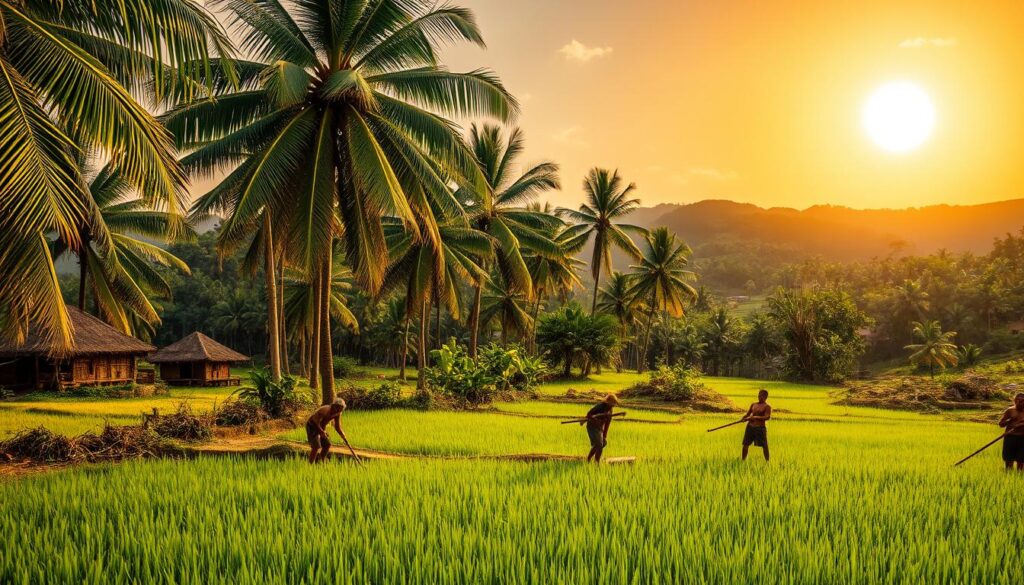
Trade Networks in Southeast Asia
The Philippines was key in Southeast Asian trade. Shipwrecks and land sites show the islands’ role in trade from the 15th to 17th centuries. Laguna de Bay was a major trade center, connecting with China and Indochina.
Pre-colonial Filipinos used ships like balangay and karakoa for trade. They traded goods with neighbors, using gold as currency. Pottery, like the Manunggul Jar, was used in ceremonies and traded.
This strong economy set the stage for the Philippines’ future growth. It shaped its trade and farming for centuries.
Spanish Colonial Era (1565-1898)
The Spanish colonial era was a key time for the Philippines’ economy. It brought new farming and trade ways that changed the country’s economy.
Introduction of Cash Crops
Spanish colonizers introduced cash crops that changed farming in the Philippines. Tobacco, sugar, and indigo became important exports. This shift changed how land was owned and the social structure of the islands.
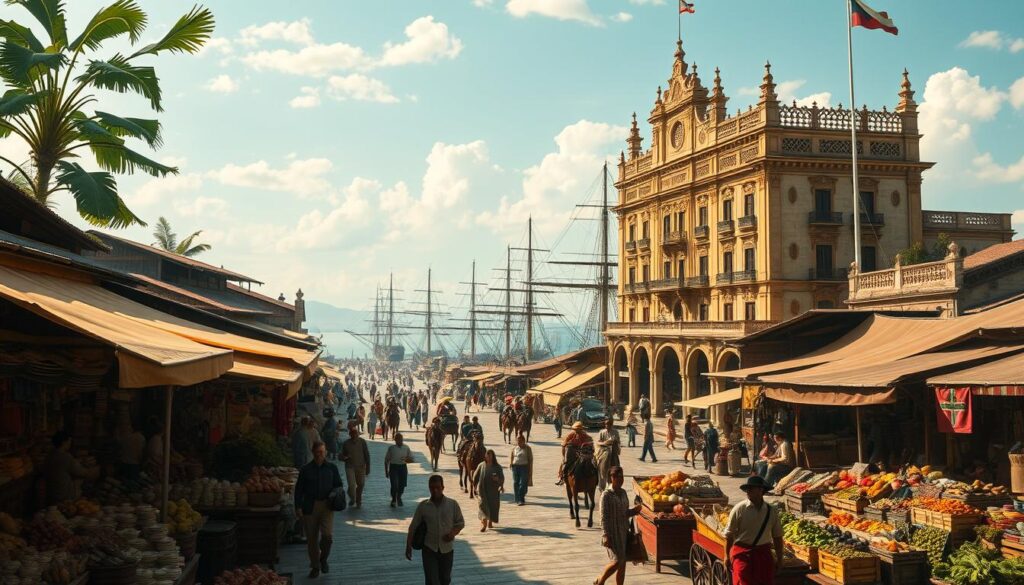
The Role of Galleon Trade
The Manila Galleon trade was crucial for the Philippines. It linked Manila to Acapulco, trading Asian goods for Mexican silver. While it made Spanish merchants rich, it didn’t help most Filipinos much.
| Goods Exported | Goods Imported |
|---|---|
| Silk | Silver |
| Porcelain | Wine |
| Spices | Olive oil |
Economic Impact of 19th Century Reforms
In the 19th century, reforms were made to improve the colony’s economy. Opening Philippine ports to world trade in 1834 ended Manila’s monopoly. This move helped grow port cities and increased agricultural exports, paving the way for future growth.
American Colonial Period (1898-1946)
The American Colonial Period was a big change for the Philippines. It brought new farming policies, industries, and a lot of new buildings. These changes helped set the stage for future economic improvements.
Changes in Agricultural Policy
American rule changed farming in the Philippines a lot. The Payne-Aldrich Tariff Act of 1909 let Philippine goods into the U.S. without taxes. This helped farming for export but hurt local factories.
Land ownership became more focused in the hands of a few. Politically connected Filipinos bought up big chunks of land.
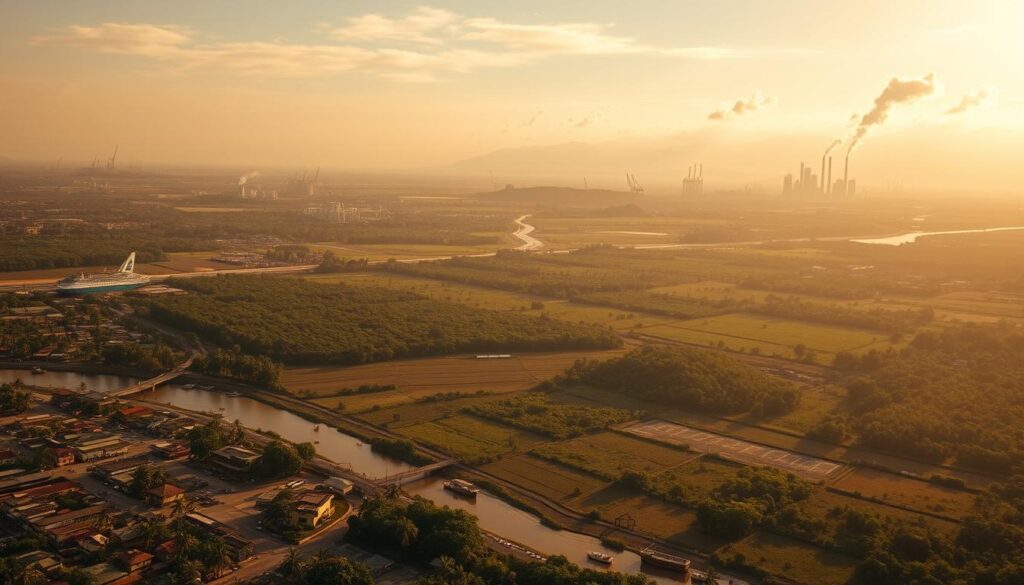
Introduction of New Industries
The American time brought commercial farming to the Philippines. Sugar and abaca exports grew a lot. This led to the rise of hacenderos, big landowners who were often Chinese-Filipino mestizos.
Infrastructure Development
Infrastructure got a lot better under American rule. Roads, bridges, and buildings were built. This made it easier to move around and do business.
The American Colonial Period was a time of big change. It shaped the Philippines’ economy in many ways. It set the stage for future growth and modernization.
Post-War Reconstruction Era (1946-1960s)
The post-war era was key for the Philippines’ economic growth. After gaining freedom in 1946, the country faced many challenges. It needed to rebuild its economy and infrastructure.
Recovery and Economic Growth
The Philippines focused on getting back on its feet. The Roxas administration (1946-1948) worked on fixing infrastructure. They also set up the Central Bank of the Philippines.
By 1965, the economy was stable. It had a fixed exchange rate of P 3.90 per US dollar.

The Role of Foreign Aid
Foreign aid was crucial for the Philippines. The United States helped with military aid, trade deals, and bases. This aid helped the economy grow but also caused political issues.
Industrialization Initiatives
The government took steps to boost industry. The Magsaysay administration (1953-1957) created the National Economic Council for planning. The Garcia administration pushed for “Filipino First” to support local businesses.
| Year | Economic Milestone | Impact |
|---|---|---|
| 1946 | Independence gained | Start of economic sovereignty |
| 1951 | Partial devaluation introduced | 17% exchange tax on foreign exchange |
| 1960 | Free market exchange rate system established | Initial rate: P 3.20 = US$1 |
| 1965 | Unitary fixed exchange rate established | Rate: P 3.90 per US dollar |
Despite hurdles, the post-war era saw growth in manufacturing and farming. By the 1960s, the Philippines had more trade partners. It also had policies to help exporters, starting a new chapter in its economy.
Martial Law Period (1972-1986)
The Martial Law era under Ferdinand Marcos was a time of both growth and challenges for the Philippines. This period saw the economy grow fast but also face severe setbacks that shaped the nation’s future.
Economic Policies Under Martial Law
Marcos’ regime had big plans to boost the economy. The Philippine GDP jumped from $8 billion in 1972 to $32.45 billion in 1980. Growth rates hit 9% in 1973 and 1976.
The government focused on building infrastructure and welcoming foreign investors. This was part of their ambitious plans.
Agricultural and Land Reform Programs
Land reform was a big push, but it didn’t help many farmers. The sugar industry struggled with low prices and demand. This made economic troubles worse.
The Negros famine in 1984-1985 hit 350,000 children. It showed the failure of agricultural policies.
Effects of Political Instability on the Economy
Political instability and corruption hurt the economy a lot. The peso’s value fell from 3.9 to 20.53 against the US dollar. External debt soared from $8.2 billion in 1980 to $26.2 billion in 1985.
Income inequality grew, with poverty rising from 41% in the 1960s to 59% in 1986. Unemployment jumped from 3.9% in 1975 to 12.6% in 1985.
- Debt-to-GDP ratio increased from 18.7% in 1976 to 57% in 1986
- GDP growth turned negative in 1984 (-7.04%) and 1985 (-6.86%)
- Bataan Nuclear Power Plant debt reached $2.1 billion
The Marcos era’s economic legacy was a mix of growth and decline. This left the Philippines with big economic challenges.
Transition to Democracy (1986-1990s)
The Philippines started a new journey towards democracy in the late 1980s and 1990s. This time was filled with big changes in the economy and the start of a new industry era.
Liberalization and Economic Reforms
The Aquino administration faced many challenges like high debt, corruption, and natural disasters. Yet, they began important economic reforms. The Ramos administration then came and brought policies to stabilize the economy and help move from farming to industry.
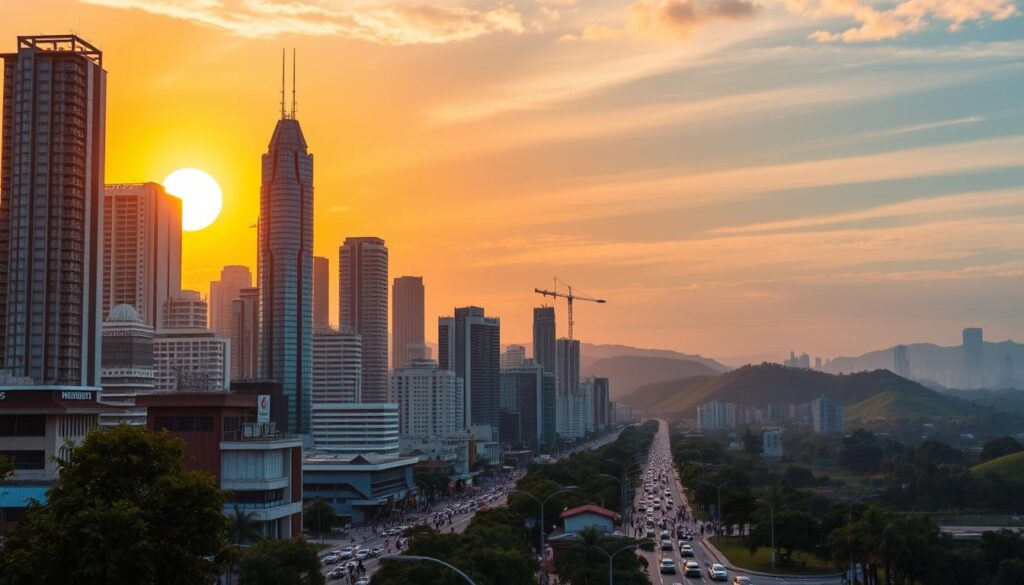
Ramos’ time saw the economy grow a bit, with a 3.6% GDP increase. He also solved the energy crisis and made peace with the Moro National Liberation Front in 1996. These steps helped set the stage for more economic growth.
Growth of Service and Manufacturing Sectors
In the 1990s, the Philippine economy slowly changed. The service sector grew, and manufacturing started to move forward. This was a big step in the country’s industry evolution. By 1999, under Estrada, the economy bounced back from a 0.6% drop in 1998 to 3.4%.
But, political scandals and instability still affected the economy. The 1992 presidential election showed a divided country, with Ramos winning by less than 24%. Despite these issues, the groundwork for future growth and diversification was laid.
Economic Crisis of the 1990s
The 1990s were tough for the Philippines’ finances. Despite being more stable than some, the country still faced big economic hurdles during the Asian Financial Crisis.
Causes of the Economic Crisis
The Philippines did better than some, but it still felt the crisis’s impact. Its GDP growth fell from 5.84% in 1996 to -0.577% in 1998. This drop was mainly because of regional economic troubles and the country’s own structural issues.
Effects on the Filipino Population
The crisis was tough on Filipinos. Unemployment jumped to 12.7% in 1998. Income gaps grew, with the richest 20% earning over half the national income. The poorest 20% got just one-twentieth. By 2006, the Philippines ranked 13th in per capita GDP in East and Southeast Asia.
Recovery Strategies Implemented
The Philippines took steps to get through the crisis:
- It kept short-term foreign currency borrowings low (19% in 1996)
- It stabilized foreign exchange liabilities with 52% owed to residents
- It strengthened the banking system, keeping non-performing loans at 15-16% in 1999
- It kept export growth positive at 16.1% in 1998
These efforts helped the Philippines deal with the crisis better than some neighbors. They paved the way for future economic growth.
Globalization and Economic Integration (2000s)
The 2000s were a big change for the Philippine economy. The country became more connected to the world economy. This changed how the economy worked.
Impact of OFW Remittances
Overseas Filipino Workers (OFWs) played a big role in the economy. Their money sent back home grew from 2.5% of GDP in 1990 to 9.2% in 2017. This helped people spend more and kept the peso stable.
Trade Agreements and Their Effects
Trade in the Philippines changed a lot. The country’s openness to trade grew from 88.1% to 101.0% of GDP from the 1990s to the 2000s. This led to more exports and more foreign investment.
Rise of the Business Process Outsourcing (BPO) Sector
The BPO sector became very important. It grew by over 50% from 2006 to 2008. This growth created jobs and brought in more money from abroad.
| Economic Indicator | 1990s | 2000s/2010s |
|---|---|---|
| Trade Openness (% of GDP) | 88.1% | 101.0% |
| Remittances (% of GDP) | 2.5% (1990) | 9.2% (2017) |
| Unemployment Rate | 7.5% (2009) | 5.0% (2017) |
These changes helped the Philippine economy grow. The 2008 global financial crisis was tough, but the country’s diverse economy stayed strong.
The Rise of the Philippine Economy (2010s)
The 2010s were a time of great growth for the Philippine economy. The country saw significant achievements and became one of Asia’s fastest-growing economies. It experienced high growth rates and changes in many sectors.
Sustained Economic Growth
From 2010 to 2019, the Philippines grew its economy by 6.3% on average. This growth made the economy stronger, with a GDP of $507.67 billion by 2025. The service sector, like business process outsourcing (BPO), was key, employing over 1.3 million people by 2022.
Infrastructure and Development Programs
The government launched the “Build, Build, Build” program for big infrastructure projects. Projects like PRDP built 2,110 kilometers of roads, cutting travel time by 66% in dry seasons. This also raised farmer incomes by up to 46%.
The ASEP project brought electricity to over 200,000 people, adding 2 megawatts of power.
Challenges Amid Progress
Despite growth, social and economic gaps still existed. Programs like Kalahi CIDSS helped, benefiting 17.5 million households, including 1.5 million Indigenous families. The BNTF supported community development in the BARMM region, helping with peace and economic growth.
The Philippine economy showed great resilience and growth in the 2010s. While challenges were there, the decade laid a solid base for future growth and social progress.
Challenges in Modern Economic Policies
The Philippines faces big economic challenges as it tries to make its policies work. Despite growing at 5% each year for a decade, poverty has gone up. This shows how hard it is to grow the economy in the country.
Addressing Poverty and Inequality
The economy in the Philippines has big problems, like low farm productivity in rural areas. A cash transfer program has helped some people, but it’s not enough. High wages and strict labor laws in the city also make things worse.
Climate Change and Economic Resilience
Climate change is a big threat to the Philippines’ economy. The country is hit hard by natural disasters, which hurt farms and buildings. It’s important to make the economy strong against these dangers.
Corruption and Good Governance
Corruption is a big problem in the Philippines’ economy. The last president fought against it, but it’s still a big issue. This makes it hard to attract foreign money, showing the need for better government.
| Economic Challenge | Impact | Policy Response |
|---|---|---|
| Poverty | Increasing despite economic growth | Conditional cash transfer program |
| Inequality | Exacerbated by labor policies | Land reform (with limited success) |
| Climate Change | Threatens economic stability | Resilience-building initiatives |
| Corruption | Deters foreign investment | Anti-corruption campaigns |
To solve these problems, the Philippines needs a plan that works on many levels. Future policies should focus on lasting growth, better education, and market solutions. This will help the country grow in a way that includes everyone and is strong against global and local challenges.
Economic Impact of the COVID-19 Pandemic
The COVID-19 pandemic hit the Philippines hard, causing big economic problems. In 2020, the country’s GDP fell by 9.6% compared to the year before. This was the biggest drop since 1946.
Before the pandemic, the Philippines was growing fast, with growth rates over 6% from 2010 to 2019. But the pandemic changed everything.
Immediate Effects on Key Sectors
The pandemic affected different areas in different ways. Tourism, retail, and hospitality were hit hard. The National Capital Region (NCR) saw its economy shrink by 10.66%.
But, other regions not near NCR had different economic stories. This shows how uneven the pandemic’s impact was.
Government Response and Recovery Plans
The government had to lock down the country to keep people safe. But this move hurt the economy too. The Philippines had one of the longest lockdowns in the world, lasting 16 months.
The government is working to get the economy back on track. They’re focusing on better healthcare and getting vaccines out faster. But, delays and doubts about vaccines slowed things down at first.
| Sector | Impact | Recovery Strategy |
|---|---|---|
| Tourism | Severe decline | Domestic tourism promotion |
| BPO | Relative resilience | Digital transformation support |
| Retail | Significant losses | E-commerce initiatives |
The government wants the economy to bounce back. They’re counting on successful vaccine distribution and help for sectors hit hard. These steps are key to beating current economic challenges and getting the country growing again.
Future Prospects and Economic Strategy
The Philippines is set for big growth in the next few years. It ranked 8th among 46 fastest-growing economies in 2023. This shows that the country’s plans are working well.
Emphasis on Sustainable Development
The Philippines is working on sustainable growth. The 2025 budget is PHP 6.326 trillion to help the economy grow. It also shows a big push for sustainable farming with more money for the Rice Competitiveness Enhancement Fund.
Innovations and Technology in Economic Growth
Technology is key for the Philippines’ growth. The CREATE Act of 2021 lowered corporate taxes for foreign companies. This encourages more tech investments. The 2022 changes to the Foreign Investment Act also help by allowing full foreign ownership of some small businesses.
Preparing for Economic Shifts Post-Pandemic
The Philippines is getting ready for life after the pandemic. The Trabaho Para sa Bayan Plan aims to create 3 million jobs by 2028. It also wants to help tourism by refunding VAT to non-resident tourists. The Public Services Act of 2023 lets 100% foreign ownership in some public services, helping the economy grow.
| Initiative | Impact |
|---|---|
| CREATE Act | Reduce corporate tax to 20% by 2027 |
| Foreign Investment Act | Allow full foreign ownership of SMEs |
| Public Services Act | 100% foreign ownership in select services |
| Retail Trade Liberalization Act | Lower capital requirements for foreign retailers |
| Energy Department Circular | Full foreign ownership in renewable energy projects |
Regional Economic Comparisons
The Philippines has seen big differences in economic growth across its regions. A study from 1988 to 2007 shows clear differences in how well each area has done. This shows both the progress and the challenges in making sure everyone grows equally.
Economic Performance in Southeast Asia
The National Capital Region (NCR) is a big economic leader in the Philippines. Its average income per person is PHP 29,669, much higher than the national average of PHP 12,396. This shows how wealth is not spread evenly across the country.
Comparative Analysis with Neighboring Countries
The study shows a complex picture of economic growth. Seven out of 14 regions are getting closer to the national average in income. But, six regions are falling behind, and none are catching up with the NCR. This is also seen in poverty rates, with NCR at 10.4% and ARMM at 62% in 2006.
To fix these issues, the government started the “Super Regions” plan. It aims to improve regional development with better infrastructure and ICT. But, critics say funding is a big problem in reaching these goals.
| Region | GRDP per capita (PHP) | Poverty Incidence (%) |
|---|---|---|
| National Capital Region (NCR) | 29,669 | 10.4 |
| National Average | 12,396 | N/A |
| ARMM | N/A | 62 |
The Role of Education in Economic Development
Education is key to the Philippines’ economic growth. It shapes the workforce and boosts innovation. The country sees education as crucial for its economic success.
Skill Development for Workforce Readiness
A skilled workforce is vital for the Philippine economy. Research shows that more schooling means better productivity and innovation. The Philippines aims to improve cognitive skills to boost earnings and growth.
Education Policies and Economic Outcomes
The Philippines is focusing on better education quality. This move is based on data showing education quality affects economic success. The country aims to close skill gaps, knowing developing nations face bigger challenges.
| Education Factor | Economic Impact |
|---|---|
| Extra year of schooling | 9% return on average |
| Human capital | Positive externalities in productivity |
| Cognitive skills | Strong influence on economic growth |
| Education quality | Critical for driving economic development |
The Philippines is working to improve education quality and quantity. This strategy matches global trends. It shows that cognitive skills and education quality are essential for economic growth and prosperity.
Conclusion
The economic history of the Philippines is a story of growth and change. It moved from focusing on agriculture to becoming more diverse and connected to the world. This shows how the Filipino people have overcome many obstacles.
Summary of Economic Evolution
The Philippines has seen big changes in its economy over time. It started with farming and was influenced by Spanish and American rule. After World War II, it tried to grow its industry and economy.
But, martial law brought political troubles that slowed down its economy. In recent years, the Philippines has opened up to the world. The BPO sector and remittances from OFWs have helped a lot. Yet, it has also faced big challenges like the 1990s crises and the COVID-19 pandemic.
Future Directions for the Philippine Economy
The future of the Philippine economy looks promising but also challenging. It needs to focus on sustainable growth, new technologies, and fairness for all. The country’s young people and digital growth are big advantages.
By using its strengths and solving problems like corruption and climate change, the Philippines can keep growing. It aims to be prosperous and stable in the global market.


